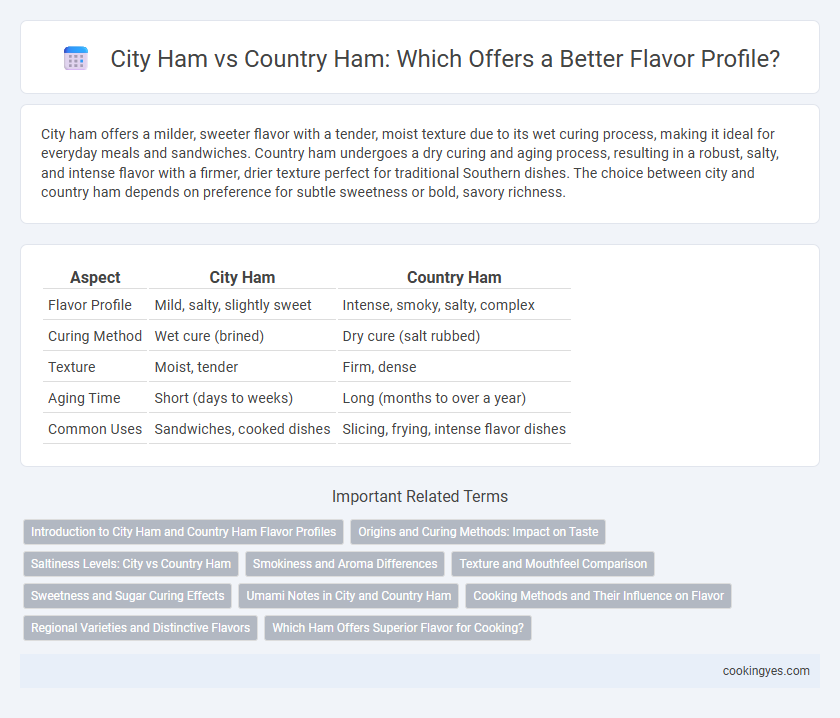City ham offers a milder, sweeter flavor with a tender, moist texture due to its wet curing process, making it ideal for everyday meals and sandwiches. Country ham undergoes a dry curing and aging process, resulting in a robust, salty, and intense flavor with a firmer, drier texture perfect for traditional Southern dishes. The choice between city and country ham depends on preference for subtle sweetness or bold, savory richness.
Table of Comparison
| Aspect | City Ham | Country Ham |
|---|---|---|
| Flavor Profile | Mild, salty, slightly sweet | Intense, smoky, salty, complex |
| Curing Method | Wet cure (brined) | Dry cure (salt rubbed) |
| Texture | Moist, tender | Firm, dense |
| Aging Time | Short (days to weeks) | Long (months to over a year) |
| Common Uses | Sandwiches, cooked dishes | Slicing, frying, intense flavor dishes |
Introduction to City Ham and Country Ham Flavor Profiles
City ham features a mildly salty and slightly sweet flavor profile, often enhanced with a smoky undertone from commercial curing processes. Country ham delivers a robust, intense saltiness combined with earthy and aged notes, developed through dry curing and extended aging in natural environments. The stark contrast between these hams highlights the influence of curing methods, regional climate, and aging duration on their distinctive taste characteristics.
Origins and Curing Methods: Impact on Taste
City ham, typically wet-cured with a brine solution and often smoked, originates from urban processing facilities in the United States, resulting in a sweeter, milder flavor profile. Country ham, traditionally dry-cured with salt and aged for several months in rural Southern regions, develops a stronger, saltier, and more intense flavor due to its long curing and drying process. The distinct origins and curing methods of city and country ham directly influence their texture, saltiness, and depth of taste.
Saltiness Levels: City vs Country Ham
City ham typically features a milder saltiness level due to its wet curing process, which balances salt with sugar and other flavorings, resulting in a subtle, less intense salty taste. Country ham, dry-cured with a heavy salt application followed by aging, delivers a pronounced salty profile, often described as robust and deeply savory. This difference in saltiness levels influences their culinary uses, with city ham favored for its tender, mildly salty flavor and country ham preferred for dishes requiring a bold, salty punch.
Smokiness and Aroma Differences
City ham tends to have a milder smokiness with a sweeter aroma due to its wet-curing process and often uses liquid smoke or minimal smoking. Country ham features an intense smokiness and robust, earthy aroma resulting from dry curing and prolonged aging in natural conditions. The pronounced smoky flavor in country ham contrasts sharply with the subtler, more delicate scent found in city ham.
Texture and Mouthfeel Comparison
City ham typically offers a moist, tender texture with a smooth mouthfeel due to its curing and smoking processes, resulting in a mild, slightly sweet flavor. Country ham is denser and firmer with a coarse grain, delivering a robust, salty taste and a chewier mouthfeel indicative of its dry-curing method. The contrast in texture and mouthfeel between city and country ham significantly influences their culinary applications and flavor intensity.
Sweetness and Sugar Curing Effects
City ham typically features a sweeter flavor profile due to sugar-based curing methods, enhancing its mild and tangy taste. Country ham undergoes a salt-heavy curing process with minimal sugar, resulting in a more intense, salty, and umami-rich flavor. The sugar curing effect in city ham promotes caramelization and moisture retention, contributing to its characteristic sweetness compared to the drier, robust profile of country ham.
Umami Notes in City and Country Ham
City ham delivers a mild, slightly sweet flavor with subtle umami notes derived from wet curing and smoking processes. Country ham exhibits a robust, intense umami profile due to dry curing and extended aging, enhancing its savory depth and complexity. The difference in curing methods directly impacts the concentration and richness of glutamates responsible for umami perception in each ham type.
Cooking Methods and Their Influence on Flavor
City ham undergoes wet curing and is usually smoked or gently cooked, resulting in a sweet, mild, and moist flavor profile. Country ham is dry-cured and aged for months, developing a concentrated, salty, and intense taste with a firmer texture through air drying. Cooking methods like baking or glazing enhance the sugary notes in city ham, while slow roasting or pan-frying intensifies the umami and smokiness in country ham.
Regional Varieties and Distinctive Flavors
City ham typically offers a milder, sweeter flavor profile due to curing with sugar and mild smoking techniques common in urban production. Country ham, often dry-cured and aged for several months in rural regions such as the Southern United States, provides a more intense, salty, and smoky taste with a firmer texture. Regional varieties like Virginia country ham are known for their robust umami flavors and complex aroma, while city hams from areas like Chicago tend to emphasize consistency and a delicate balance of sweetness.
Which Ham Offers Superior Flavor for Cooking?
City ham, typically wet-cured and smoked, offers a milder, saltier flavor profile with a moist texture ideal for quick cooking methods. Country ham undergoes dry curing and aging, developing an intense, complex, and saltier taste with a firmer, drier texture suited for slow cooking or slicing thinly. For superior flavor in cooking, country ham's bold, concentrated flavors often provide a richer culinary experience, especially in dishes needing a punch of umami.
City ham vs Country ham for flavor profile Infographic

 cookingyes.com
cookingyes.com